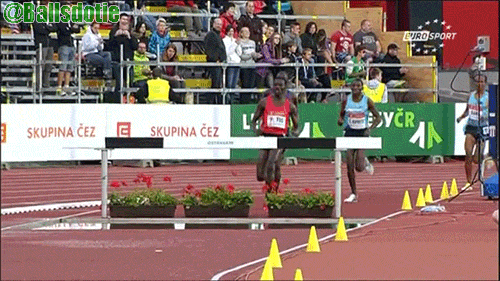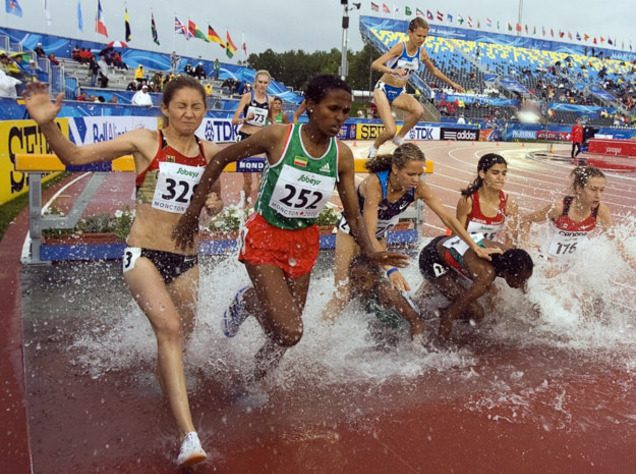Steeplechase Basics
The steeplechase is a unique event in Track and Field in that it combines endurance, speed, and agility into one frenzied, athletic competition. Steeplechasers must be tough mentally and physically, finding the strength and determination to race over the hurdles despite intense fatigue. Ultimately, the steeplechase breaks down like this: 3,000m run that incorporates thirty-five total hurdles — twenty-eight of them have dry landings, while the other seven finish in water.
Training for the steeplechase is very similar to preparing for other distance events, such as the 1,500m, 3,000m, and 5,000m races. However, clearing the barriers presents additional challenges, especially as the event continues and your legs get heavier and heavier. To maximize efficiency during the race, steeplechasers have to hurdle and water jump correctly, confidently, and consistently. Even just one fall will probably cost you your chance at winning. If that sounds exciting, well, that’s because it is! Take CoachUp’s guide to the steeplechase with you the next time you’re training and you’ll see improvements in no time.

The Aprroach
First and foremost, you should begin mentally prepare to clear the barrier when you’re about twelve steps away from it. Ideally, your jump should seamlessly and rhythmically integrate into your stride. Taking off too soon or too late will throw you off and effectively waste your energy. Additionally, hesitating before the hurdle is a sure way to add seconds to your time. You cannot be nervous or afraid as the hurdle draws closer. By hesitating, you are only increasing your chances of a fall. Instead, be aggressive!
Learn to accelerate slightly right before the barrier, this will propel you forward and over it. By practicing the approach, your body will eventually get used to the amount of steps that is most comfortable for you and will adjust more easily to the proper position in the future. Steeplechasers must also be prepared for the worst as they frequently have to deal with competition hurdling right beside them, sometimes even pushing or making other physical contact. Beginners to the event should practice by mixing up their approach. Try varying your pace or hurdling beside other runners — both these variables are likely to affect the distance at which you take off to jump. You will likely have to make similar adjustments during a race, so it is important to mix up the conditions of your approach in practice.
Clearing the Hurdle
Since the steeplechase is much more contingent on endurance, it requires a slightly less aggressive hurdling technique. Thanks to the slower pace, the forward lean as steeplechasers clear the barriers is less drastic and resembles jumping more than hurdling. In addition, runners do not need to count steps between hurdles. In this event, successfully clearing the hurdle is much more dependent on being able to adapt to changing conditions rather than following a premeditated race plan.
Beginners will sometimes step on the barrier, but avoid doing this as much as possible! Stepping is much less efficient than jumping over, however, as your legs get more tired, it may be key to continuing an efficient race pace. When hurdling, each leg serves a specific purpose. Experienced steeplechasers will be able to clear the barriers without a preference for a lead leg, but this is something to work up to. Here is a basic breakdown of hurdling technique:
Lead leg
Your lead leg typically corresponds to the dominant hand — or, the hand that you write, shoot, or eat with, so pay attention! This means that right-handed athletes will use their right leg as the lead and vice versa for lefties. The lead leg is extended with your ankle dorsiflexed as it drives forward and over the hurdle. As your leg undergoes this motion, your opposite arm should mimic this movement. Starting with your shoulder height at a 90° angle, thrust this arm forward. Just as when you are running normally, make sure that your arms are tucked in close to your body.
Trail Leg
As your lead leg comes up to clear the barrier, your trail leg should come up towards your buttocks with your foot flexed and pointing out to the side. This leg should stay close to your body and the form should resemble the number 7 as much as possible. As you clear the hurdle, your lead leg should land first, followed by the trail leg. By continuing the driving motion with your arms, you will maintain balance as you land and transition back into running right away. Think of the hurdle as part of your stride, so that you continue running at the same pace after clearing it.
Getting Over
Again, we must stress — do not be afraid of the water jump! Jumping into water can sound daunting, but in reality, it requires much of the same strategy as the other barriers. The biggest difference is that instead of clearing this barrier, jump-step onto to the barrier so that you land on your lead leg. The heel of your foot should hit the back of the barrier, so your foot can roll over the top as your momentum carries you forward.
Just as with the other barriers, you want to drive with as much forward momentum as possible–jumping up and out rather than just upwards, which is not as productive. To avoid wasting this momentum, make a mental note to keep your body weight low as low as possible. Ideally, land with one foot in the water with the next step resuming the running on dry land.
(Related: Read about strategy for long distance runners here.)
Huddle Up
The steeplechase is an event for runners who can acutely develop their hurdling skills in a different way than usual. In addition, steeplechase athletes need to train with a focus on physical endurance as well as mental toughness. Countless races have been determined by the last hurdle, when a runner hesitates or falls, giving up the win to the next in line, so stay centered on finishing a race until the very end. But, remember that even if you fall, a quick recovery will help you compensate for lost seconds, and a determination to succeed will take you far.
If the steeplechase sounds like fun, we highly suggest chasing that desire! However, we understand that it can be a little daunting at first, so stick with it. Or, consider booking one of CoachUp’s private trainers to help you out along the way. Our experienced team will have you tackling the hurdles, water, and track with awesome confidence! What are you waiting for?
How useful was this post?
Click on a star to rate it!
Average rating 4.7 / 5. Vote count: 41
No votes so far! Be the first to rate this post.




3 Responses
I would like to know if you are allowed to touch the hurdle with your hands.
With the hurdles in the steeplechase fixed to the ground, runners are allowed to vault themselves over by any means necessary. Using hands or feet may not be the most efficient way to clear the obstacles, but as long as runners go “over” each of the hurdles rather than “around” them, they have followed the rules of the race.
Yes, you can!